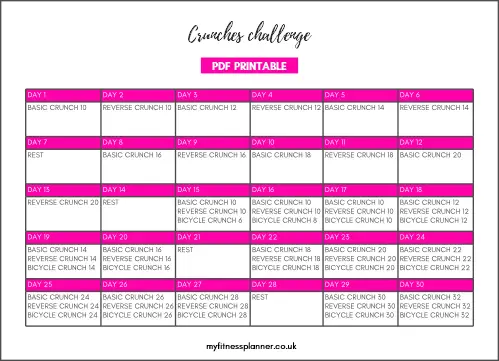There are 4 layers of abdominal muscles, but it’s the top layer that gives the trained, 6 pack look. These are the muscles that are worked by crunches. Basically an abdominal crunch involves bringing your upper body and lower body closer together in some way. In this crunches challenge, there are 3 variations of ab crunch – the standard crunch, reverse crunch and bicycle crunch. The challenge gets a bit harder each day by adding more reps of the exercises, as shown in the chart. See the end of the post for how to get the challenge PDF.


About the crunches challenge workout
The challenge is suitable for beginners, but please check these general safety guidelines before you start.
You’ll need to be on a surface that is comfortable for your spine. If you don’t have an exercise mat, lie on something soft, a folded blanket or quilt for example.
The instructions for the 3 exercises are below, followed by a chart with the reps for each day of the challenge. You can also get a printable download by entering your e-mail at the bottom.
# 1 Basic crunch

- Lie with your knees bent, feet flat on the floor about hip distance apart.
- Put your hands behind your head to prevent neck strain. You should just be supporting your head, not pulling on it.
- Keep your elbows relaxed out to the side.
- Engage your abdominal muscles and curl your spine smoothly away from the floor.
- Stop when your shoulder blades have left the floor and start to reverse the movement. Again, it should be a smooth, curling movement on the way down.
#2 Reverse crunch

- This time, start by extending your legs so that they are vertical.
- Engage your lower abs as you curl your lower spine off the mat in a smooth curling movement.
- When your lower back has left the floor, start to reverse the movement – curl your spine back down under control.
#3 Bicycle crunch


- The start position this time is with your feet in the air and your hands behind your head.
- Bring your right knee towards your upper body and, at the same time, lift your left shoulder off the floor and reach your left elbow towards your right knee.
- Repeat on the other side.
Crunches challenge schedule
Get the crunches 30 day ab challenge PDF
Sign up for My Fitness Planner updates and get a link to the ab challenge PDF e-mailed to you:
After you sign up, you’ll get 2 e-mails, one will have a link to your printable download and the other will be a welcome e-mail.
If the e-mails haven’t turned up within a few minutes, please check your junk folder, as some service providers have very strict filters.
Related to crunches challenge


Challenge FAQs
The first day of the challenge should feel like it needs a bit of effort, but not too much. If you really struggle with day 1, then you probably won’t get through the challenge. The idea with the challenges on this site is that the first few days get you used to the exercises and the daily habit. Usually about halfway through the challenge the effort levels start to increase more quickly.
Avoid challenges that increase effort levels very quickly – they’re simply not realistic. It’s unlikely that, for example, you would be able to increase how many squats you are able to do by 10 a day for 30 days, or increase your plank hold time by 10 seconds a day for 30 days.
In general, allowing muscles 48 hours between workouts is good because it gives our bodies time to recover and adapt. Challenges are generally short workouts and for a limited period of time (usually 30 days), so not having many rest days won’t be a problem. With challenges that alternate exercises each day, it’s not an issue, because you’re using different muscles.
Fitness improvements don’t always happen in a predictable way. Sometimes we’re just not as strong or energetic for no apparent reason, or we hit a plateau. If you get to a point where you’re struggling to complete the day’s challenge, you can try one of the following:
- Take a couple of days off and start again where you left off
- Do the challenge on alternate days rather than every day
- Instead of increasing the effort every day, stay at the same level for 2 or 3 days and then go onto the next day of the challenge
Obviously these solutions mean the challenge will last longer, but you’ll still benefit from doing it.
